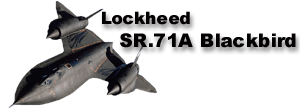

|
 |
 |
In the words of Kelly Johnson, "It makes no sense to just take this one or two steps ahead, because we'd be buying only a couple of years before the Russians would be able to nail us again. No, I want us to come up with an airplane that can rule the skies for a decade or more." He wanted to design an airplane that used conventional engines and fuel, but still be able to outrace any missile.
The Blackbird, code-named Oxcart during its development, flies on a tremendous 65,000 lbs. of thrust at an altitude of 100,000+ feet at Mach 3.5, and has a range of four thousand miles.That is not only four times faster than the U-2 but seven miles higher - and the U-2 was then the current high-altitude champion. For a long time the Air Force claimed a maximum speed of Mach 3.2 and an operational ceiling of 85,000 feet, but we now know that the SR-71 can soar above 100,000 feet. Some military pilots claim altitudes in excess of 125,000 feet but this is probably stretching it a bit. Compared to the fastest jet fighter America had at the time, the SR-71 flew at least 60 percent faster than its maximum speed on afterburner. Experimental rocket engines had flown this fast for only two or three minutes at a time before running out of fuel. But the Blackbird can cruise at more than three times the speed of sound, and fly coast to coast in less than an hour on one tank of gas. The aircraft can also survey more than 100,000 square miles of the Earth's surface in one hour. The Blackbird actually stretches a few inches during flight, due to the massive temperatures on its titanium hull. To many, the Blackbird is the epitome of grace and power, not to mention blinding speed.
As of January 1st, 1997, two SR-71 air crews and planes were declared mission ready for the first time since the plane's retirement, seven years ago. In 1994, Congress appropriated funds to put two aircraft back into service, and these airplanes were taken out of storage, refurbished, and delivered to the USAF. (One was located at NASA's Dryden research facility and the other at the Skunk Works.) These two Blackbirds and their crews are now based at Edwards Air Force Base, though administratively, they are part of the 9th Recon Wing at Beale. These SR-71s are equipped with reconnaissance sensors, including the Advanced Synthetic Aperture Radar system that provides near real-time, all-weather, day or night imagery.
"My goal was to bring the SR-71 back quickly, within budget, and most importantly, in a safe manner," said Brig. Gen. Robert Behler, 9th Reconnaissance Wing commander at Beale. "I'm proud to say we've accomplished this goal and we look forward to demonstrating a mobility capability later this year."
Another of Lockheed's Kelly
Johnson's creations, the SR-71 Blackbird set the world speed record
in 1965 and has held it ever since. Originally called the RS-71
by Lockheed, it was mistakenly referred to as SR-71 by President
Lyndon Johnson and no one wanted to correct him, so the SR designation
stuck. The secrecy that surrounded this aircraft was astounding,
as the Air Force would never formally acknowledge the SR-71's
until well into the 1970's. The aircraft is constructed totally
of titanium alloy and incorporates original stealth technology.
The plane flew so high and so fast that many technical problems
had to be overcome during produuction. Not really black but deep
indigo blue, the paint is special, heat dissipating and radar
absorbent, as skin temperatures can reach 1100°F in flight.
Heat causes the fuselage to expand six inches in flight, requiring
flexible fuel tanks. The plane literally leaks fuel on the ground
until high speeds are reached in flight. The SR-71 uses a special
JP-7 high temperature jet fuel and at top speed needs refueling
every 45 minutes. The fuel doesn't burn easily and it takes a
chemical reaction to start the engines. Cameras in the SR-71 can
map 100,000 square miles in less than one, and wears out its tires
in six landings. A fighter interceptor version was contemplated,
but since it takes three states to turn around at top speed, the
idea was not deemed feasible. Upon retirement, an SR-71 was donated
to the Smithsonian Institute and in a farewell flight, flew from
Los Angeles to Washington DC in 68 minutes, again setting a world
speed record. The true capabilities of this plane may never be
known since security and human pilot limitations restrict the
aircraft.
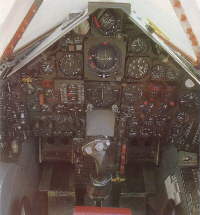
|
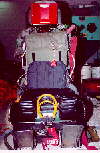 |
How fast does the SR-71
really go.......?
The fastest published speed of the SR is Mach 3.5. There are several
factors that limit the speed of the SR, one is the shock waves
generated by various parts of the plane, at around Mach 3.6- 3.8
the shock wave off the nose of the aircraft narrows enough to
go into the engine, while there is the inlet spike (which slows
the air to subsonic before it enters the engine), the shock wave
bypasses the spike and causes the engine to unstart.
Second is the heat generated by the plane moving through the atmosphere,
even titanium has it's limits, and the heat generated by the SR
brings the fuselage to the brink. Just recently I found out that
during a Lockheed Skunk Works study to see how much money and
development it would take to get the SR to go faster than it's
designed top speed 3.2- 3.5, the designers discovered (among other
things) that the metal divider between the windshield was heating
up so much above mach 3.5 that it was affecting the integrity
of the windshield, and at that point they had stretched the glass
technology to the max! So Mach 3.2 to a max of 3.5.
Now according to Richard Graham: "The design Mach number of the SR-71 is 3.2 Mach. When authorized by the Commander, speeds up to Mach 3.3 may be flown if the CIT limit of 427 degrees C. is not exceeded. I have heard of crews reaching 3.5 Mach inadvertently, but that is the absolute maximum I am aware of."
How high does the SR really
fly, and do the Pilot and RSO get astronaut wings after flying
the SR?
The SR doesn't fly quite that high, the highest altitude I've
heard attributed to the SR was 100,00 ft (18.93 miles), all the
Air Force and Lockheed admit to is above 80,000 ft. To get astronaut
wings you have to fly at least 264,000 ft (50 miles). Which the
SR (even though it's a fantastic aircraft) doesn't get close to
that altitude!
Richard Graham contributes: The SR-71s engines require a sufficient quantity of air in order to operate. The maximum altitude limit is 85,000 feet unless a higher altitude is specifically authorized. Again, I have heard of crews inadvertently reaching 87,000 feet, but no higher.
What does it cost to
fly the SR-71?
There are lots of numbers floating around about how much it costs
to fly the SR, I've heard figures over $100,000 an hour to fly
the SR-71, and a $1,000,000 a picture. The figures are all over
the place, it's especially hard, because you can figure it so
many different ways....do you include Tanker support, flight proficiency
ops (SR "B" model and T-38), and numerous other expenses.
I like to figure it as what it actually costs to fly the airplane
itself, no training, tanker support, etc. So with that said.....The
numbers that I've been told by people that know is $38,000 per
flying hour. The costs can be lower to a rock bottom price of
$27,000 per hour if the annual flying time gets above 300 hours
total. So the actual cost is probably somewhere in between 38
and 27 thousand an hour.
Well after the latest Wings episode "Spyplanes" on recently, some interesting errors! Well here goes....
"The SR takes off with
almost dry tanks"
Well not exactly empty, the SRs tanks hold 80,000 lbs. of fuel,
the SR-71 usually takes off with 45,000 lbs. of fuel on board.
Not what I call almost dry! The SR takes off with either 45,000
lbs., 55,000 lbs., or 65,000 lbs. of fuel. Almost all flights
are refueled by KC-135Q's (now "T"), there are a few
exceptions though... one was called the "Rocket Ride",
which were flown from Kadena AB, Okinawa and then on to Northern
Korea, on 65,000 lbs of fuel. The only SRs that launched with
a full fuel load were the test flights from Palmdale, CA
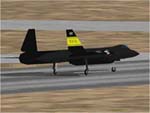 |
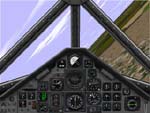 |
|
SR-71 for FS98 (764kb) |
|